Typhoon Haiyan: UN launches $301m Philippines aid appeal
- Published
George Alagiah looks out from a helicopter at the damage caused by Typhoon Haiyan
The UN has launched an appeal for $301m (£190m) to help relief efforts in typhoon-hit areas of the Philippines.
Thousands of people are feared to have been killed by Typhoon Haiyan, which struck the central Philippines on Friday.
The UN says more than 11 million people are believed to have been affected by the storm, and some 673,000 displaced.
The relief operation is being stepped up, but food, water and shelter are still badly needed aid officials say.
Several countries have deployed ships and aircraft to help, but the damage to transport links and bad weather are hindering aid distribution.
Tacloban - a city of 220,000 on Leyte island - is particularly badly affected.
The BBC's Jonathan Head described how the main road from the airport to the city was clogged with refugees and debris, with residents becoming angry at the lack of progress and increasing breakdown in security.
Bodies remain uncollected, local government has been wiped out, and central government, which is meant to have taken over, is almost invisible, our correspondent says.
Local officials have been reported as saying at least 10,000 people may have been killed by the typhoon, but CNN quotes President Benigno Aquino as saying this may be "too high" and the true figure could be in the range of 2,000 to 2,500.
The National Disaster Risk Reduction and Management Council (NDRRMC), external has put the official death toll at 1,774, as of early Tuesday morning, with 2,487 wounded and 82 people listed as missing.
Valerie Amos, the UN's Under-Secretary-General for Humanitarian Affairs and Emergency Relief, is in Manila to head the aid operation.
"We thought it was our last day": Survivors talk to the BBC
She told the BBC the storm had been far worse than expected, and that people in the affected regions were "absolutely desperate".
"They need food, they need water, they need shelter. People need to be protected," she said.
Helicopters were also in urgent need to help with assessing the damage, she said.
Baroness Amos told reporters the UN would work alongside the Philippine government, and that efforts would focus on "food, health, sanitation, shelter, debris removal and also protection of the most vulnerable".
"I very much hope our donors will be generous," she said.
The operation is expected to be one of the most challenging the UN has ever mounted. Survivors are scattered across several of the 7,000 islands which make up the Philippines and many of the affected areas have not yet been reached.
Security fears
The UN has already released $25m to address the immediate needs of survivors.
Secretary General Ban Ki-moon described the situation as "heartbreaking".
Aid agencies have warned that the security situation is worsening.
There are reports of food warehouses and grocery shops being ransacked and people starting to fear for their safety.
An aid convoy travelling to Tacloban is reported to have been attacked and two of the assailants shot dead by troops.
Bodies of typhoon victims are lying in the streets or buried under rubble. Some have been buried in mass graves.
The airport at Tacloban has been severely damaged, meaning aid planes were not able to land for some time, though they are now arriving at regular intervals.
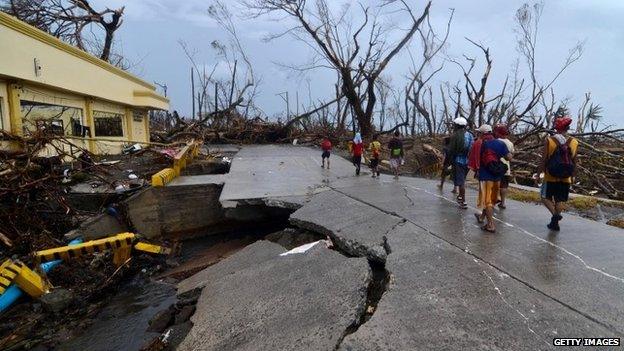
The damage to infrastructure is making the aid effort more difficult
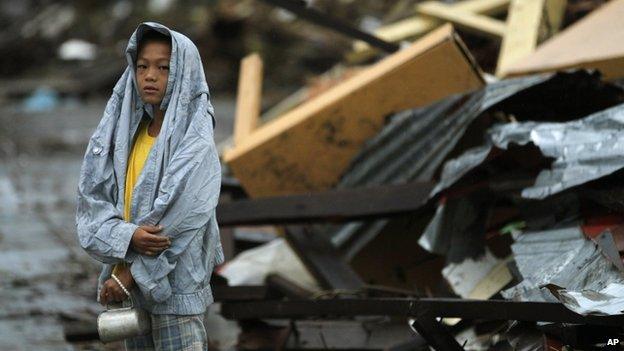
Thousands of survivors desperately need food, water and shelter
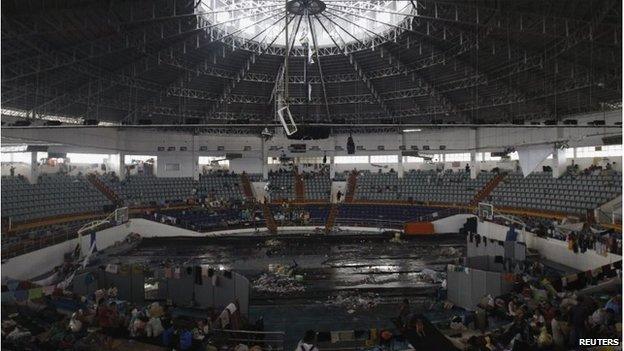
Some survivors have sought shelter in a convention centre in the ruined city of Tacloban, on Leyte island
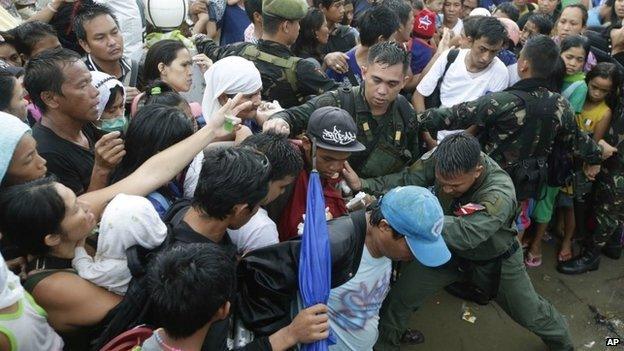
Residents of Tacloban, desperate to leave, were restrained by police at the airport
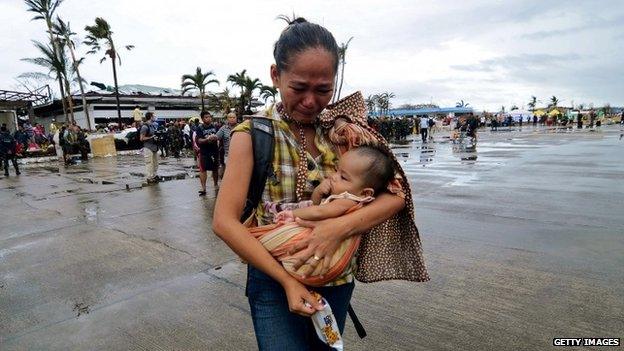
As the relief effort gathers pace, hundreds of people are being evacuated from the affected areas
Large crowds gathered at the airport hoping to be evacuated, leading to scuffles with the security forces.
One woman hoping to be flown out said she had had to leave the body of her grandson at a temporary morgue in a hotel. Her son and his wife were also died.
"I asked the mortuary to give my son and his wife proper coffins, but they told me their staff had not reported for work and that some of them were probably dead as well," Maria Adelfa Jomerez told the AFP news agency.
"There are no vehicles to transport them to the cemetery anyway. I would prefer that they not be buried in a mass grave, but I cannot do anything about that."
A spokesman for President Aquino said aid was gradually going in.
"We are not going to leave one person behind, one living person behind," the Associated Press quotes him as saying.
The Philippines air force has been flying C-130 transport planes in and out of Tacloban, carrying relief supplies and evacuating hundreds of residents, a military official told AP.
Planes carrying aid are stuck on the tarmac in Cebu, as BBC correspondent Tim Willcox reports
The US is sending its aircraft carrier USS George Washington and other navy ships to help with the relief work. The carrier is expected to arrive within the next few days. The UK's Royal Navy destroyer HMS Daring is also making its way from Singapore.
Other countries have also pledged millions of dollars in assistance. Japan is providing $10m and Australia $9m in humanitarian aid, while New Zealand has pledged over $1m.
'Like 2004 tsunami'
Haiyan - named "Yolanda" by Philippine authorities - struck the coastal provinces of Leyte and Samar on Friday. It was one of the most powerful storms on record to make landfall.
Hundreds of thousands of people were evacuated before the typhoon arrived, but many evacuation centres were unable to withstand the winds and storm surges.
Haiyan brought sustained winds of 235km/h (147mph), with gusts of 275 km/h (170 mph) and waves as high as 15m (45ft).
The typhoon then headed west, sweeping through six central Philippine islands and into Vietnam, where state media said at least 13 people had died.
At least six were also reported killed in southern China, after Haiyan tore through Hainan province and the Guangxi Zhuang autonomous region over the weekend, state media reports.
In the UK, the Disaster Emergency Committee (DEC) group of 14 charities launched its own appeal to help the typhoon victims on Tuesday.
DEC chairman Salah Saeed compared the destruction in the city of Tacloban to that seen after the devastating tsunami of 2004.
"There is currently no food, water or electricity. We can only imagine how much worse the situation will be for families living in towns and remote villages," he said.
